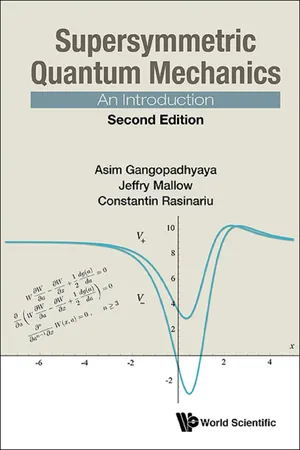
Supersymmetric Quantum Mechanics
An Introduction
- 296 pages
- English
- ePUB (mobile friendly)
- Available on iOS & Android
Supersymmetric Quantum Mechanics
An Introduction
About This Book
-->
We have written this book in order to provide a single compact source for undergraduate and graduate students, as well as for professional physicists who want to understand the essentials of supersymmetric quantum mechanics. It is an outgrowth of a seminar course taught to physics and mathematics juniors and seniors at Loyola University Chicago, and of our own research over a quarter of a century.
-->
Request Inspection Copy
--> Contents:
- Introduction
- Quantum Mechanics and Clues to SUSYQM
- Operator Formalism in Quantum Mechanics
- Supersymmetric Quantum Mechanics
- Shape Invariance
- Supersymmetry and Its Breaking
- Potential Algebra
- Special Functions and SUSYQM
- Isospectral Deformations
- Generating Additive Shape Invariant Potentials
- Singular Potentials in SUSYQM
- WKB and Supersymmetric WKB
- Dirac Theory and SUSYQM
- Natanzon Potentials
- The Quantum Hamilton-Jacobi Formalism and SUSYQM
- The Phase Space Quantum Mechanics Formalism and SUSYQM
- Solutions to Problems
-->
--> Readership: Undergraduates, graduate and academics in physics. -->
Keywords:SUSYQM;Supersymmetry;Quantum MechanicsReview:
Reviews of the First Edition:
“This work is appropriate for anyone with a solid background in upper-division undergraduate mathematics and physics … The problems, which are scattered throughout the chapters, were very well chosen.”
CHOICE
“The book under review provides, to undergraduate and graduate students of physics as well as to professional physicists, a basic theoretical background of SUSY QM. This book can be recommended reading for people interested in SUSY QM, the present book has been written keeping in mind junior and senior researchers that can understand quickly these subjects through a lot of examples, figures and problems (with solutions).”
Zentralblatt MATH
Key Features:
- It is the only text on this topic that is specifically designed for and tested on undergraduates
- It contains an accessible presentation of the ab initio method of generating all of the traditional Shape Invariant potentials
- Connects Quantum Mechanics and Supersymmetric Quantum Mechanics throughout
Frequently asked questions
Information















Table of contents
- Cover Page
- Title
- Copyright
- Dedication
- Preface
- Contents
- 1. Introduction
- 2. Quantum Mechanics and Clues to SUSYQM
- 3. Operator Formalism in Quantum Mechanics
- 4. Supersymmetric Quantum Mechanics
- 5. Shape Invariance
- 6. Supersymmetry and its Breaking
- 7. Potential Algebra
- 8. Special Functions and SUSYQM
- 9. Isospectral Deformations
- 10. Generating Additive Shape Invariant Potentials
- 11. Singular Potentials in SUSYQM
- 12. WKB and Supersymmetric WKB
- 13. Dirac Theory and SUSYQM
- 14. Natanzon Potentials
- 15. The Quantum Hamilton-Jacobi Formalism and SUSYQM
- 16. The Phase Space Quantum Mechanics Formalism and SUSYQM
- 17. Solutions to Problems
- Bibliography
- Index